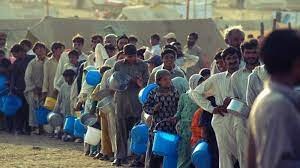ISLAMABAD: Agricultural and food security is impacted by the rising temperatures brought on by climate change, which also makes extreme weather events like droughts and floods more frequent. This will carry on into the future, endangering water resources and water security, reports WealthPK.
During the period from 1961 to 2018, Pakistan’s average annual temperature increased by 0.74 degrees Celsius, according to the latest research conducted by the Pakistan Institute of Development Economics on the impact of climate change on water in Pakistan. In future, Pakistan’s projected annual temperature rise is expected to be much higher than that of the rest of the world, it added.
According to the research, both increasing and decreasing trends in rainfall have been observed in Pakistan over the last century. The rainfall will increase in future under all emission scenarios. This is due to an 80 to 100-kilometer shift in the summer monsoon trend from northeast to northwest. As a result, districts in Punjab and Khyber Pakhtunkhwa are vulnerable to flooding.
The following figure explains the annual mean precipitation trend in Pakistan during the period from 1995 to 2100.
Based on the Intergovernmental Panel on Climate Change’s highest emission scenario (RCP 8.5), global temperatures are projected to increase by 3.7 degrees Celsius, compared to Pakistan, where they are projected to increase by 5.3 degrees Celsius.
The global sea level is rising at an increasing rate, according to the research. This is due to a similar trend in Pakistan, which is caused in part by the massive glacier and ice melt.
It added that Pakistan is vulnerable to flooding and saltwater intrusion into its agricultural plains and freshwater resources due to its long and densely populated coastal areas, particularly Karachi.
Research shows that the average temperature in Pakistan rose by 0.60 degrees Celsius between 1901 and 2000, and the annual rise in sea level is estimated to be 1.1mm. The seawater intrusion has already significantly reduced farmland in Sindh. The graph below depicts a projected increase in sea level of 0.3 to 0.8 meters under all emission scenarios.
Among other things, the research found a strong correlation between extreme summer temperatures and migration of humans. It further stated that climate shocks affect agricultural productivity in rural areas, which erodes the incomes of poor and marginalized farmers.
According to the study, rural households may make migratory decisions to avoid rural income losses, which may be exacerbated by climatic stress. Such changes are expected to be exacerbated by 2030 in Pakistan’s arid and semi-arid areas, which are important for wheat production and home to the majority of the country’s rural population.
Given the sensitivity of wheat crop to heat stress, a decrease in wheat production is expected to affect rural poor and marginalized households across Pakistan, it added.
According to the study, the Indus Basin accounts for 96% of Pakistan’s total available freshwater resources. Around 80% of the freshwater comes from outside the country, making it extremely risky and vulnerable.
It added that glacier melt, snow melt, and rainfall runoff account for 10%, 55%, and 35% of total water in the Upper Indus, respectively. The Upper Indus provides over 85 percent of the total water in the Indus, which is shared by Pakistan (53 percent of the total area of the Indus), India (33.5 percent), China (6.7 percent), and Afghanistan (6.3 percent).
According to research, stream flow in the Upper Indus basin is highly seasonal: approximately 80% of the annual stream flow in the Upper Indus basin tributaries occurs during the summer months of mid-June to mid-September.
To address the looming water crisis in Pakistan, the study made the following suggestions.
Firstly, to regain storage capacity, policymakers must rethink water policy by encouraging wastewater recycling, groundwater recharge, and local-level surface water storage.
Secondly, a gap must be filled between policies, reform, and implementation. The government must implement a major paradigm shift that encourages more prudent water use.
Lastly, an institution with regional responsibilities for sharing water resources needs to provide mechanisms for exchanging data and information; facilitate the forming of more robust water-sharing agreements, especially in relation to climate change and hydrological variability; and ensure that pollution issues are addressed and flood management is improved.





